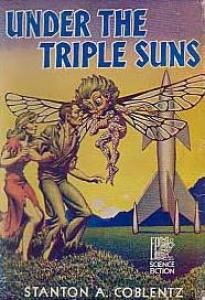A planet with three suns in its sky staggers the imagination — how can a stable orbit exist for such a world? In fact, the only references are science fictional, which is why Maciej Konacki, a senior postdoctoral scholar in planetary science at Caltech, refers to the first such planet to be found as a ‘Tatooine’ planet. The name is a nod to Luke Skywalker’s home world in the first of the Star Wars movies. An earlier science fiction reference might be Stanton Coblentz’ Under the Triple Suns (1955), one of the few novels to posit planets around star systems this complicated.
But Konacki isn’t writing science fiction. He found his Jupiter-sized planet around the triple star system HD 188753 using a new method of measurement that lets him examine stellar velocities even in close multiple-star systems. Such systems have generally been avoided by planet hunters because precision velocity measurements are much easier to make around single stars, and also because theory suggested that planets were unlikely even in binary systems, not to mention triple-star environments.
But Konacki persisted, and to good result. From a Caltech news release:
“If we believe that the same basic processes lead to the formation of planets around single stars and components of multiple stellar systems, then such processes should be equally feasible, regardless of the presence of stellar companions,” Konacki says. “Planets from complicated stellar systems will put our theories of planet formation to a strict test.”
 The view from a moon orbiting the new planet would be spectacular indeed, as shown in the image to the right. The Jupiter-class world dominates the view at top left. HD 188753 is a G-class star, hence its yellow color as it sets beyond the mountains (bear in mind that the new planet orbits the primary star in only three and a half days, so it’s in close). The larger of the other two stars is orange, the smaller red; both remain visible in this artist’s conception of the scene (credit: California Institute of Technology).
The view from a moon orbiting the new planet would be spectacular indeed, as shown in the image to the right. The Jupiter-class world dominates the view at top left. HD 188753 is a G-class star, hence its yellow color as it sets beyond the mountains (bear in mind that the new planet orbits the primary star in only three and a half days, so it’s in close). The larger of the other two stars is orange, the smaller red; both remain visible in this artist’s conception of the scene (credit: California Institute of Technology).
The three stars around which Konacki’s planet orbits are about 149 light years from Earth, and are as close to one another as the distance between the Sun and Saturn. The new planet directly challenges existing theories of planetary formation (as so many new planetary discoveries seem to do). Shouldn’t the protoplanetary disk around a star be distorted by the presence of two companion stars? In fact, HD 188753’s two stellar neighbors should truncate the disk so severely that no planet would have space to form, and yet clearly one has.
 Just for fun, here’s the opening of Coblentz’ Under the Triple Suns, describing the view from the planet onto which a trio of Earthmen — the last survivors of the human race — have just landed:
Just for fun, here’s the opening of Coblentz’ Under the Triple Suns, describing the view from the planet onto which a trio of Earthmen — the last survivors of the human race — have just landed:
“The red sun glowed high in the copper heavens. It was as wide as a dozen moons, and of the color and brightness of smoldering embers; and it did not end sharply as a disk should, but terminated in a nebulous crimson fringe. It shed its rays like a dying fire over a great sweep of wooded, partly hilly country, terminated in the distance by saw-toothed mountains, and marked at closer range by the loop of a cascading river and the oval of a lake, and by a cluster of shimmering beehive structures that billowed and fluttered in the breeze.
“After a time, above the serrate edges of the far-off ranges, a white illumination began to spread; and the mist-banks about the peaks, ruddy before, took on a sheet-like glare as a globe that seemed of a hand’s width slowly swam into sight. Although much smaller than the red sun, it dominated the scene by its intense hot flame.
“The white orb was about fifteen degrees above the horizon when another light began to emerge. Of an almost unbearable brilliance, it looked not much larger than a silver dollar; but its companions seemed almost pale beside its terrible sea-blue incandescence. Evidently the blue sun and the white belonged together, like the earth and the moon; and the three luminaries, along with a Saturn-like ringed fourth that had no fire of its own but glowed red, white or blue according to the influence of the moment, circled with a gradual movement from west to east.”
Under the Triple Suns was published by Fantasy Press in 1955, after first appearing in Astounding Stories in October of that year. No less a science fiction critic than Damon Knight once praised it for its inventiveness in creating an utterly alien world and society.

